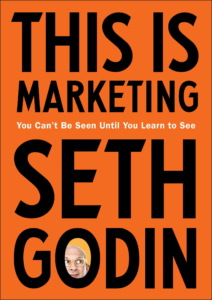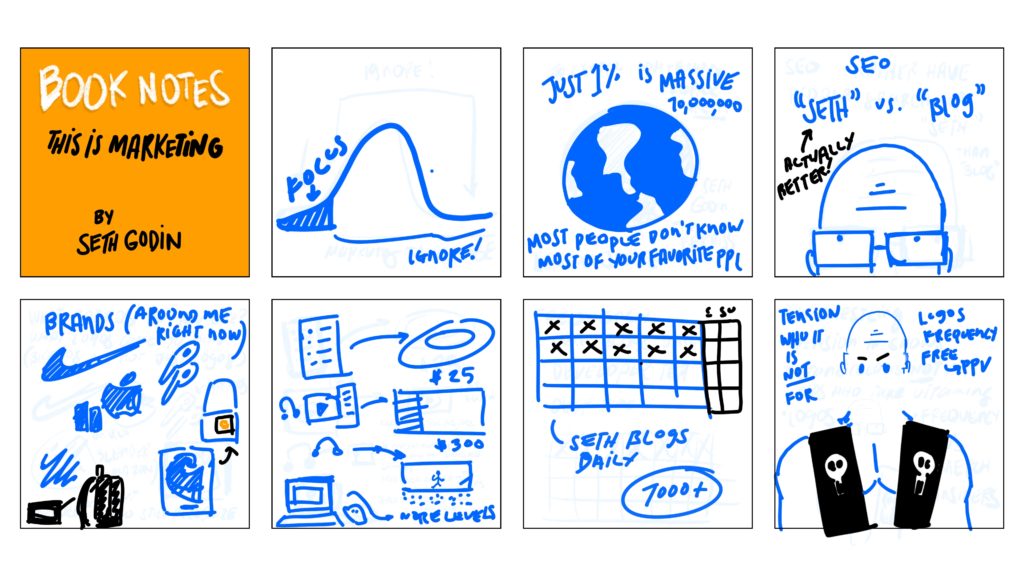
Check out the full notes for “This is Marketing: You Can’t Be Seen Until You Learn To See” by Seth Godin
Hulk Hogan told millions of kids to eat their vitamins. Stone Cold didn’t. They were both wildly popular wrestlers. I learned everything I know about marketing by watching 90s wrestling.
I should probably learn more, so I picked up Seth Godin’s This is Marketing this week.
Here are some takeaways.
Find a focus and ignore the rest

Anyway, good to see a standard deviation curve that isn’t showing me how terrible I’m doing. Seth explains that a part of the curve (left of where most people clump together) represents neophiliacs. Focus on them. And what about the rest of the curve?
From This is Marketing:
Good marketers have the humility to understand that you shouldn’t waste a minute (not of your time or of their time) on anyone who isn’t on the left part of the curve.
You can’t change their mind. What you make is not for them.
That’s okay. Spare your energy.
Most people don’t know most people
“I don’t think about you at all.”
It’s one of my favorite lines from Mad Men. I try to remember it whenever I worry that I said something dumb in front of a group. Or when I think someone might be upset with me.
Ok so that’s not exactly the point of this section, I just wanted to share that. Mad Men itself is the point. Or the popularity of Mad Men. Or, one more try, the lack of popularity of Mad Men, depending on how you looked at it.
At its peak, it seemed like every pop culture critic wrote about or referenced Mad Men. Which is great but it didn’t mean that everyone beyond that was actually watching Mad Men.
From This is Marketing:
Today, though, popular culture isn’t as popular as it used to be. Mad Men, which was hyped by the New York Times in dozens of articles in just one season, was only regularly seen by 1 percent of the U.S. population.
On Tim Ferris’s podcast, Seth points out that most people don’t know Tim Ferriss. Of everyone you walked past today, 99 out of 100 people don’t know who Tim is. Still, he’s wildly successful. (Same goes for Seth.)
NBA players are really popular on social media. Until you start comparing them to global soccer stars.
Here’s the good thing. You don’t have to be nearly that popular to have an audience to build a career around.
Mad Men didn’t need to be seen by as many people as Johnny Carson. You don’t need to be known by as many people as Tim Ferriss.
You can start by aiming for something much smaller.
SEO is one thing, but it’s better for people to be searching for you
I used to be the first image search result for “machete costume”. It was a fun icebreaker when joining a new team.
SEO is useful, but It’ll be a long, hard battle if you’re trying to make it to the first match of any generic search term.
Why try showing up for “blog” when you can have people just search for your name?
From This is Marketing:
The path isn’t to be found when someone types in a generic term.
The path is to have someone care enough about you and what you create that they’ll type in your name. That they’ll be looking for you, not a generic alternative.
Yes, you can find my blog by searching for “blog” in Google.
But I’d rather have you search for “Seth” instead.
How do you get there? It’s simple, not easy: be good enough. You get good enough by showing up frequently and building trust.
(I also just want to explicitly acknowledge that “first image search result for ‘machete costume’” isn’t exactly the same in value as being the first search result for “blog”.)
What brands are around you? Why? (You probably like them.)
A brand isn’t just a logo. But a logo can be an important element.
From This is Marketing:
Here’s a simple exercise: Make a list of five logos you admire. As a consumer of design, draw or cut and clip five well-done logos.
Got ’em?
Okay, here’s my prediction: each one represents a brand you admire.
I looked around at the different things around me while writing the first draft of this. I wrote it at a gym. It wasn’t Equinox but if I said I wrote this at Equinox you might have a picture in your head of what my environment looks like. Their brand is clearly more than just their logo.
Oh yeah, the things around me.
I had multiple Nike things on. Easy to draw that logo from memory.
I was drawing on an iPad. I know the logo is an apple with a bite in it but I had to look at it to draw it. I had AirPods with me. Which are clearly apple and again go to show that brands go beyond logos.
Then there were a few other things with logos I couldn’t have drawn from memory at all.
I had a Uniqlo jacket and pants. Couldn’t describe the logo to you except that it’s geometric.
GORUCK has a logo but it’s not anywhere on the outside of my backpack. That said, I notice when other people have the same bag. And I always assume they must like their bag as much as I do.
I also had a logo on that I couldn’t draw from memory but can recognize on someone across the street: the Carhartt wave (?) on a beanie.
Give stuff away. If it’s good enough people will pay for your paid stuff.
This post is free.
I don’t sell anything.
If enough people read enough of my free things then some day I can sell something. (And hope that I’d be mentally strong enough to deal with some backlash.)
Anyway, many things you pay for are likely to be connected to something else that was free.
Ever watched a chef on TV?
From This is Marketing:
When a chef gives away her recipes, or appears on a podcast, or leads an online seminar, she’s giving her ideas away for free. It’s easy to find them, engage with them with frequency, and share them. But, if you want to eat that pasta served on china on a white tablecloth at her restaurant, it’s going to cost you twenty-four dollars.
The last artist you saw at a concert probably has a song for free on the radio. (Or there’s somewhere online where you can listen after skipping through a commercial.)
Did you ever have a Windows computer with one level of Doom on it? Free. If you beat it then you could pay for more levels. And it was completely worth it.
Podcast hosts have free interviews with people, but those people are often showing up to spread an idea. And you can get the premium version of that idea by buying their book.
Write 7000 posts
Why did I pick up “This is Marketing”? I trust Seth’s advice. I don’t know him but I’ve read and listened to a lot of his work. I’ve written a few times about how important his idea of “write in the editor” has been for me for finishing work. (He writes his daily blog post directly into TypePad. Because when he’s in there, his mind knows what to do.)
That trust was built up over time by reading his work regularly. He shares new things regularly. You don’t get to 7000 posts by posting 1000 posts a day for 7 days. You get to that by posting consistently year after year.
Show up. Finish. And show up again.
All I know about marketing I learned from pro wrestling
“Oh. Give me. A hell yeah!”
If you recognize Stone Cold Steve Austin you might have read that in his voice. He built that recognition by showing up.
Wrestlers show up. It’s fake fighting, yes.
People will say “it’s fake fighting” in a disparaging way. But imagine how hard that is.
There’s a stadium with 10s of thousands of people. Now go make that entire place pop.
With a fake fight.
And they do it. Night after night.
They’re serious athletes going through grueling work. They show up and travel town to town to put on a show. Night in and night out. They build trust with the fans. With that frequency.
Beyond the importance of frequency, here are some other ways wrestling applies concepts from “This is Marketing”:
- Brands and logos: It’s not a logo, but whenever I hear a glass break in the kitchen when I’m sitting in a restaurant, I picture Stone Cold walking into the room.
- Not for everyone: Stone Cold was for the kids who grew up and decided they’d start washing down their vitamins with a Steveweiser. If you were still saying your prayers and believed only in 100% good and 100% evil, he probably wasn’t for you. And that was fine by him.
- Some free, some paid: You could see him on TV week in and week out. Want to see him fight for a championship? Fork some cash over for a pay-per-view. (And nowadays, The Network.)
- Status: Pro wrestling is not an elite thing. The people that care about wrestling don’t care about what outsiders think. Outsiders don’t get it. But they do care about status relative to other fans. People that soak in New Japan Pro Wrestling shows and cruiserweight tournaments are different from the fans that are completely absorbed in mainstream storylines. If one of your favorite guys from the indie scene makes it big, then your status is raised for being an early adopter.
I’ve scratched the surface but check out “This is Marketing” for more.
While you do that, I’ll pat myself on the back for showing up today. Then I’ll start thinking about how to show up tomorrow. And the next day. And the next day.
And I’ll say my prayers and express gratitude that the next days don’t involve taking chair shots to the head.







